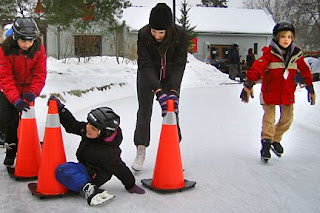 |
| Canon S90 set to automatic and hand-held. Image enhanced in Photoshop. |
London, Ontario, has a great ice pad at Storybook Gardens. The rink is scheduled to open this coming Sunday and staff are hustling to prepare a proper ice surface. The weather is cooperating, its cold, and workers are spraying the cold concrete with water.
 |
| Shot at dusk and the sky darkened in Photoshop. |
But the beauty of the Storybook Gardens rink is not just its size, it's an almost kilometer long loops filled with gentle curves. The rink is situated in a park dedicated to well-known storybook characters and stories. Kids can find Humpty Dumpty in the park, and the Old Shoe that served as a home for the old lady and her brood, and more. In winter, Christmas lights add to the atmosphere.
It is a cool spot and recently I had the chance to get some images of the park prior to its opening.
The trick here is to try and tell a story. Clearly the watering of the ice pad is a core image. For this you must set some clear goals: The water spray must be backlit to make it pop in the dark, the pavement must be wet with puddles to reflect the colourful lighting, and the large size of the pad and its curved shape must be clear. Shooting at dusk makes this all just a little easier. The shutter speed is faster. Still, bracing the camera on any solid, suitable surface is an excellent idea.
The Christmas lighting must feature in at least one shot. The outline of a steam locomotive was the obvious shot but it was important to include of the curving ice trail in the picture. This photo essay is about a location and we must work to locate each picture, where possible.
 |
| After getting permission, I shot the train lights from behind. Note the rink. |
I have often heard folk complain about the poor focus of their point-and-shoots. This can be a problem, I must admit. That said, I use point and shoots as I can't afford better. (I'm retired.) One trick that will work with almost all cameras is to aim the camera at whatever must be in focus, partially depress the shutter release (this causes most cameras to focus), and then with the release kept depressed you recompose your image and shoot. With today's oh-so-smart cameras you may have to watch the on-screen focus indicators to be sure that both you and the camera agree on what should be in focus.
Remember to shoot lots. This is especially true if you are shooting for the Web. You are not constrained by a finite expanse of paper on the Web, so take advantage of this fact. The rink can be seen behind the Christmas lighting locomotive but it is not especially clear. Punch up your photo story with one good image of the rink.
Photoshop is expensive. I own a copy because I am an ex-teacher and ex-photojournalist. At the least consider buying a program like Photoshop Elements to punch up you images before "publishing" your images on the Web. I like to think of this as electronically printing my pictures. Photoshop is my electronic darkroom.
 |
| Action's important. |
Lastly, if you have any pictures in your files to round out your photo story, now is the time to dust off one or more of those images. Voila! You've told your story.

Oh, one last thing: Simple news pictures do not require model releases before publication. Even so, I often speak to the people in my images and make sure that they do not object to being in one of my online publications. If someone were to object, I would remove their image without argument.
To see how this approach worked with the same pictures presented on a different site, read my article on photostories posted on
Digital Journal.












